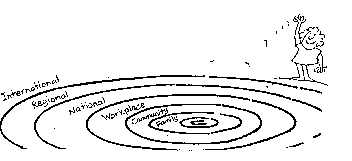
|
||
The World Alliance for Breastfeeding Action (WABA) is a global network of individuals & organisations concerned with the protection, promotion & support of breastfeeding worldwide. WABA action is based on the Innocenti Declaration, the Ten Links for Nurturing the Future and the Global Strategy for Infant & Young Child Feeding. WABA is in consultative status with UNICEF & an NGO in Special Consultative Status with the Economic and Social Council of the United Nations (ECOSOC). |

|
Maternity Legislation: Protecting women's rights to breastfeed
Today, more and more women of child-bearing age are working outside the household, in work that keeps them far from home for long hours with rigid regimes. Increasingly, women are seeing themselves and being viewed by society as independent economic units responsible for their own economic survival and well-being. In 1990, 828 million women were officially estimated to be economically active in the labour force. Since the definition of economic activity excludes such unpaid work as subsistence agriculture, house-work and child care, the actual figures for women at work are far higher. The majority of workers are also parents; women's dual role as workers and mothers needs to be viewed in its entirety. Society must respect and accommodate women's productive and reproductive roles. Child bearing is a biological function that only women can assume. Yet, society denies most women maternity benefits. Maternity benefits are basic human rights for women. Women who are employed are entitled to paid maternity leave because it is a health measure to protect mothers and infants in late pregnancy and the early post-natal period. Maternity leave is essential to allow a mother to recover from birth, breastfeed her infant and to give her the opportunity to spend time with and provide care and nurturing for the young child to help the child adjust to a new environment. Paid maternity leave guarantees a continuing source of income and employment security following delivery. Women who receive maternity leave are more likely to remain in the workforce: this has economic benefits for employers; social benefits for women, families and society. "The promotion of breastfeeding must not be seen as an excuse to exclude women from the labour force. The burden should no longer fall on women to choose between breastfeeding and work. The burden is on society to facilitate breastfeeding and indeed child care". Traditional societies recognised the need for pregnant women and women who had recently given birth to benefit from additional social support. In many societies, the extended family provided a six-week period of rest and seclusion, or at least, help with household chores, for women who had given birth. For example, in Africa, the woman's mother-in-law looked after her and her baby in many societies for one to six months. This ensured that mother and baby bonded and breastfeeding became well established and maintained. In addition, the mother would be relieved of her normal household chores and she would be given special foods. Often a ceremony of re-integration into society marked the close of this period of social withdrawal. Increasing urbanisation and dislocation of the extended family have weakened these mecha nisms of social support to enable mother and baby to rest and recover together. Maternity legislation has been introduced in some countries as a step towards replacing these social traditions. The International Labour Organization (ILO) regulates a wide range of international and labour issues through standards that are contained in Conventions and Recommendations adopted by the International Labour Conference. Conventions are like international treaties; once ratified, they create specific, binding obligations. The 1919 Convention Number 3 of the International Labour Office provides international standards on maternity protection for women employed in industry and commerce; it calls for 12 weeks of maternity leave with cash benefits and prohibition of dismissal and one hour per day breastfeeding breaks. In 1952, this was revised to include women workers at home and provide for higher protection: 14 weeks maternity leave, higher cash benefits including remunerated breast-feeding breaks and more employment security. Two Recommendations, one from 1921 (Number 12) and one from 1958 (Number 110) extended the scope of the protected group of women workers to women employed in agriculture and on plantations. The 1979 Convention on the Elimination of all Forms of Discrimination against Women (CEDAW) states "Parties shall prohibit, subject to the imposition of sanctions, dismissal on the grounds of pregnancy or maternity leave ... shall introduce maternity leave with pay or with comparable social benefits without loss of former employment, senio-rity and social allowances". To date, the 1919 and 1952 Conventions have been ratified by 29 and 22 countries respectively. Actions In 1988, Elisabet Helsing of the WHO regional office for Europe said: "If society hinders the optimal breastfeeding by mothers who work outside the home, society needs to change, not women". This change will come about only if we mobilise action for change. Maternity protection measures concern all of us. Whether you are a mother-to-be, or a husband, sister, brother, grandmother or grandfather of a mother-to-be, the protection of working women concerns YOU. Wherever you work, you can act to bring about changes to enable and support all mothers to breastfeed!
Throw the stone The stone represents the minimum requirements to enable women to work and breastfeed. We must throw the stone in and create the ripples of social support to change society. YOU can throw the stone to create the ripples and help to shape the laws to protect women's rights to maternity protection:
Existing provisions The 1985 ILO global survey of maternity benefits analysed national legislation of 127 countries for which information was available. This review found that the average length of maternity leave in the world was between 12 and 14 weeks. Approximately 25% of the countries provided less than this average; many of these were developing countries. In 1990, the IBFAN Latin America Coordinating Officer reviewed maternity leave provisions in 28 countries in Latin America and the Caribbean. Like the ILO survey, IBFAN found that many countries have laws and regulations concerning maternity leave. The nature and scope of the provisions varied: laws relating exclusively to maternity protection, laws on female labour, labour codes, laws on conditions of employment in certain sectors of the economy, social security laws and labour ordinances or regulations. A large number of countries also have collective agreements to reinforce and supplement existing legislation or fill the gap where there is no such legislation. In spite of these provisions, many women do not have maternity protection because these provisions mainly cover women who are employed in the formal sector. Also, there is very little information available about the enforcement of these provisions. There are some reports that often women do not take full advantage of maternity protection laws and regulations because they themselves are not aware of them. In Guatemala, women with social welfare coverage are entitled to 75 days of maternity leave. They are entitled to 100% of earnings during maternity leave which is to be paid by the employer if the workers are not covered by social welfare. There is prohibition of dismissal on account of pregnancy and provisions exist for nursing breaks when women return to work. The Ministerio de Trabajo y Previson Social and Oficina Nacional de la Mujer, in collaboration with the Comision Nacional de Promocion de la Lactancia Materna has developed an illustrated booklet to inform women about existing laws. Costs A central issue in the debate concerning maternity leave is who should pay for it and how. A common argument against paid maternity leave is that it is costly to the employer. To estimate the true cost of maternity leave, employers need to consider the cost of alternatives, for example, the cost of replacing the employee. Studies show that often it is far less expensive to support leave than to replace an employee. It should be noted that the taking of maternity leave would have a low incidence in the working lives of women in Australia, it is estimated that only about 2.8% of the total labour force are potentially eligible for maternity leave annually. Models and guidelines for estimating cost can be found in the Australian document "Paid Maternity Leave" and the Family and Work Institute manual "Parental Leave and productivity". The discussion paper on paid maternity leave by the National Women's Consultative Council of Australia points out that where provisions are voluntary, they tend to benefit mainly highly paid women in the formal sector. Employer funded maternity leave is likely to increase retention of skilled staff, encourage employer investment in human capital and bring productivity and staff morale as well as facilitate an expansion in the national skills base. Unfortunately, it could also create disincentive to employ women of child bearing age, increase casualisation of the workforce and create difficulties for small business. The advantages of individual funding are: there are no large increases in government spending and no disincentives to employ women; casual workers are able to participate and receive benefits. However, this option does not recognise the social value of children, only more highly paid women would be likely to afford to make savings and would probably be feasible for the first baby. Government funding would ensure that maternity benefits are available to lower-paid women as well as more highly paid women. But it would involve increase in government spending, could be subject to income tests unlikely to be paid at wage rates, and so could become a targeted income support payment not linked to employment. Ideally, the cost for maternity leave or benefits should be shared between the government, employers and individuals. Each employer and country needs to review their policies and find the best mechanism to ensure universal access to maternity benefits such benefits must reach the employed and unemployed. To achieve this, it is likely that legislation will be needed to issue the mandate and ensure compliance. Legislation is important but will have little or no impact if the necessary resources for implementation are not available. The role of government is to set a climate of opinion and to create an enabling environment rather than deliver all services. Governments can take a lead in acknowledging that child care is the responsibility of society as a whole. They can then encourage attitudes on the part of men and employers that ensure that they too take on their share of the task, both in the home and in the workplace. Maternity Protection - A Call for Action
Source of graphics provided by IWTC (International Women's Tribune Centre).
This activity sheet was developed by Alison Linnecar, Geneva Infant Feeding Association and Virginia Yee, Clearinghouse on Infant Feeding and Maternal Nutrition in association with the WABA Information Task Force. GIFA WABA |
 |
World Alliance for Breastfeeding Action |
||
| Site Map | PO Box 1200, 10850 Penang, Malaysia | Tel: 604-6584816 | Fax: 604-6572655 | E-mail: waba@waba.org.my | http://www.waba.org.my | |

